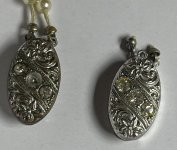I'm sorry for your loss! My mother also loved pearls and her very favorite strand was some nice imitations. That generation liked imitation strands and wore them often.
I don't recognize the clasps. Perhaps someone else will. Is there a mark on them of any kind, whether brand name or type of metal?
I hope the following pointers will help you feel more confident in your assessment of whether the pearls are real or fake-- and if fake, whether they are of lower quality.
There are some ways one can tell if pearls are fake or not. The one I find myself recommending more often these days is the
temperature test. Real pearls are cooler than either glass or plastic pearls. Place the pearls you wish to test in the same ambient temperature environement with some other pearls that you know to be real (or know to be fake). Then test by holding the test pearls briefly to your lips, which are highly temperature sentitive. Do the same with the other pearls that you know are real (or fake). What do you feel?
There is another test commonly called the
tooth test-- but please
don't rub the pearls on your teeth! I stopped recommending that after reading that someone had scratched a pearl that way. Teeth are harder than pearls and therefore can scratch them. Instead, rub 2 of the pearls in the necklace gently against
each other.
I suggest using a pearl from each end of the necklace, near the clasp (just in case!) What do you feel? Real pearls feel gritty, while imitation pearls glide smoothly, if clean (if grimy they may stick a bit). This is true even of my high end fakes (Majorica brand.)
If you have a jeweler's loupe (a 10x magnifier), you can examine the surface of the pearls. At that magnification, real nacre looks very smooth (assuming you are not looking directly at a blemish) while imitation pearly coating looks a bit coarser. This, too, is true even of my high end Majorca fakes.
Real pearls typically have very small drill holes; the reason is that pearls are sold by weight and a smaller hole helps preserve weight. Imitation pearls usually have larger drill holes and thus take thicker thread, which makes larger knots. However, this is not always true. My Majorica pearls have small drill holes.
Real pearl necklaces generally have some blemishes, however tiny. If a strand has zero blemishes, it is more likely to be fake.
Real pearl necklaces have overtone colors, if they are lustrous. Not every pearl looks
exactly the same. Same goes for size...they may be close but not
exactly the same size. This is because real pearls form within living mollusks so they are not a calibrated size. Akoya necklaces that are a straight size (not graduated) are typically composed of pearls that are within 0.5mm or each other --for example, 6.5-7.0 mm, or 7.0-7.5 mm. If every single pearl looks
exactly the same in color and size, they are likely fake. Pearls made in factories are typically a calibrated size. But there can be exceptions. I had some vintage fakes that were just a bit different from each other-- deliberately, to look more real.
Look for any places where the pearl coating has peeled, revealing the glass or plastic bead underneath. You would not see this with real pearls.
Examine around the drill holes for these traits that are indicative of a lower quality fake:
• beveled drill hole
• swirls of excess pearly coating
Also-- the weight of the necklace. If very light, the bead is plastic. Glass beads are pretty common for fakes, so if they are plastic, they are super cheap pearls.
You may like to have a look at this thread:



